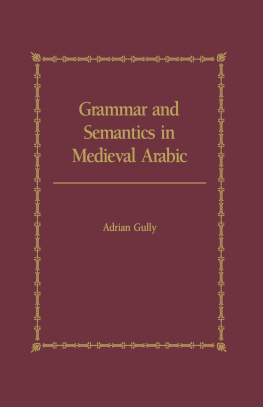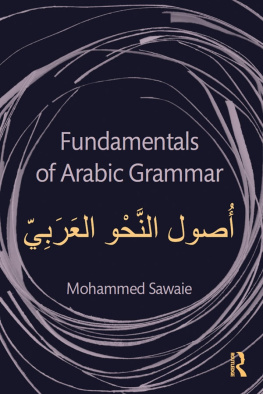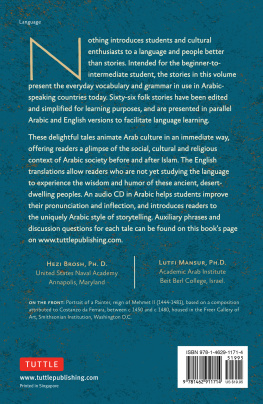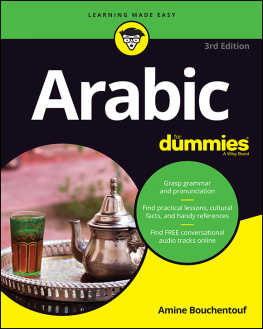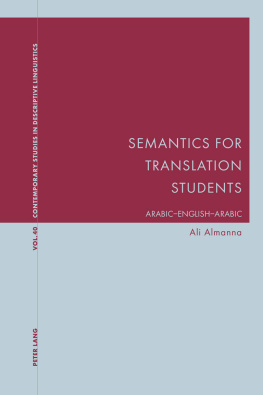
Grammar and Semantics in Medieval Arabic
For all those working in the field of medieval Arabic linguistics
Grammar and Semantics in Medieval Arabic
A study of Ibn-Hishams Mughni l-Labib
Adrian Gully

First published 1995 by
Curzon Press Ltd.
Published 2013 by Routledge
2 Park Square, Milton Park, Abingdon, Oxon OX14 4RN
711 Third Avenue, New York, NY, 10017, USA
Routledge is an imprint of the Taylor & Francis Group, an infomza business
1994 Adrian Gully 1995
British Library Cataloguing-in-Publication Data
A CIP record for this title is available on request from the British Library
ISBN 13: 978-0-700-70302-9 (hbk)
All rights reserved. No part of this book may be reproduced or transmitted in any form or by any means, electronic, mechanical, photocopying, recording, or otherwise, without the prior written permission of the publisher.
CONTENTS
ACKNOWLEDGEMENTS
One of the pleasures of compiling a piece of work such as this is to be able to thank all those people who made it possible. To the following I owe an enormous debt:
The late Professor M.A. Shaban who advised me so judiciously at an early stage to embark on a study of medieval Arabic in some form. Although it has often been a struggle, I am indebted to him for this direction. I am extremely grateful to Dr Michael Carter of New York University who provided the initial inspiration for the Doctoral Thesis, and whose writings and words of wisdom have continued to stimulate and influence me. Dr Kees Versteegh of the University of Nijmegen has not only been a considerable source of encouragement to me through his writings, but kindly went through the completed version of my PhD thesis in his own meticulous way, and gave me such invaluable assistance with his remarks. In fact, his suggestions added a new dimension to the revision of the thesis; needless to say, however, that remaining imperfections in this work are entirely of my own making. Paul Auchterlonie, the Arabic subject librarian at Exeter University has been unfailing in his assistance with book queries and in chasing references. He is also responsible for the indexing of this work which he has compiled in his own inimitable and flawless style. Thanks are also due to Heather Eva of Exeter University Inter-Library Loans who has been unstinting in her efforts to fulfil all book loan requests. Dr Ian Netton, the Head of the Department of Arabic and Islamic Studies at Exeter has granted all my wishes with a sympathetic understanding. I would also like to extend thanks to Toby Morris and Professor Yasir Suleiman at the University of Edinburgh for their combined assistance in overcoming several typographical problems during the latter stages of preparation of this work, and to Linda Morris for her substantial contribution to the production of the final drafts. My family and friends also deserve a special mention for the many concessions they have made during the period of my writing this book.
Finally, love and thanks are due to my wife Nancy who has not only given us a beautiful daughter, Anya, during the busiest time of my life, but has remained a constant support and encouragement throughout the long days of toil which were necessary to complete this work.
PREFACE
Given the increasing constraints imposed on the development of Arabic grammar after the first few centuries of Islam, it is to the credit of the Arab grammarians that they have provided modern scholarship with sufficient material to inspire the intellectual pursuits that have often proved as fruitful and as stimulating as the polemical debate that spanned the age of medieval Arabic grammar itself. Yet in spite of some of the different approaches adopted to the study of grammar during that period, particularly by those grammarians of the fourth century A.H. who brought principles of logic and philosophy to bear on linguistic analyses, it is fair to say that the later development in particular of the science of Arabic grammar was more lateral than anything else. This is hardly surprising when we consider that the mainstay of grammatical studies was the corpus of material taken from the sacred text. The nature of this material meant, of course, that it could be regarded as nothing less than immutable.
However, this situation has in no way dispirited modem scholarship. In fact, a great deal of time and energy has been spent in attempting to understand and elucidate the types of issues that interested the medieval grammarians. Even if one takes the view that Arabic grammar became an increasingly intellectual and theoretical discipline with decreasing practical value, one can not overlook the complexity of the subject which has stimulated such vast interest. It is perhaps surprising, therefore, that in a discipline where old theories were frequently re-worked, and new ways of saying the same thing were often presented in an innovative fashion, some of the later grammarians also happen to be those who have made a significant and lasting impact on more recent grammatical studies. Indeed, Bohas et al. (1990:15) have noted that it was during this later period in particular that grammatical science reached a hitherto unknown degree of formal perfection. If this is the case, there is every justification for selecting a later grammarian for a more comprehensive analysis. To this end we have chosen to focus on one of the most famous of the later grammarians, Jaml al-Dn Abd Allh ibn Ysuf Ibn Hishm, who died in 761/1359.
This present work is a revised version of the authors Doctoral Thesis which was examined in July 1991. It focuses on a treatise of grammar and semantics by Ibn Hishm called Mughn l-Labb an Kutub al-Arb. The Mughn has always been held in high esteem by scholars of the medieval period who had access to this work. It is clear from the extent to which some of these later scholars incorporated many of I-Hs ideas that they regarded it as a major contribution to Arabic grammar. This view has been shared by more recent scholarship too. Yet ML is not merely a work of grammar. I-H himself wrote many tracts along the more traditional lines of other grammatical works which belong to an extremely rich and invaluable linguistic legacy left to us by the medieval grammarians. However, there are many factors which set ML apart from these other contributions to the science. One of the main reasons for selecting ML as the focus of this study is that I-H adopted a technique of analysing Arabic grammar that demonstrates a more acute awareness than many of his predecessors of semantic trends.
Like his predecessors, I-H also lived and studied in a climate of considerable intellectual output. To suggest, however, that ML reflects a general approach to grammatical studies at that time would be to undermine his achievements. On the other hand, evidence is beginning to emerge that he was perhaps not the only scholar of that period who was concerned with issues that pertain more to meaning than form. Larcher (1990/1992) has already described some of the pragmatic elements which are evident in the Shar al-Kfiya of al-Astarbdh (d.684 or 686/128588), for instance, although it should be noted here that the techniques employed by both I-H and al-Astarbdh were very different. No doubt there is a lot more to be said on this subject and on the latters work in particular. At all events the question of meaning is never far from consideration in ML, even though I-H may not always treat it as a separate consideration to the form of a given linguistic issue. Of particular interest to us here is whether I-H develops what could constitute a separate semantic theory in ML, since it will soon become clear that his main concern with the language is as much semantic as formal.
Next page
